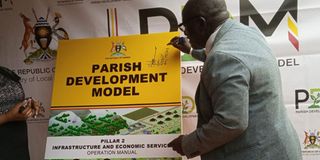PDM execution at 63 per cent – NRM

What you need to know:
- PDM, an ongoing government intervention for wealth creation, aims at pulling households out of poverty.
As the National Resistance Movement (NRM) took stock of its mid-term findings on April 25 to ascertain the progress so far made from its 2021-2026 manifesto where it pledged several commitments, it has revealed that the implementation of the Parish Development Model (PDM) action areas so far stands at 63 per cent.
PDM, an ongoing government intervention for wealth creation, aims at pulling households out of poverty.
“The evaluation findings revealed that the majority of beneficiaries of PDM are female (55 per cent) and male (45 per cent). Of these, special interest groups like the youths (29 per cent), elderly (13 per cent) and persons with disability (7 per cent) are also considered as beneficiaries in the PDM,” the Manifesto Implementation Unit director, Mr Willis Bashaasha said during a Thursday review meeting held in Kampala.
Over Shs1 trillion, the findings revealed had been disbursed for PDM.
Besides findings ascertaining the progress attained in the respective sectors, the NRM mid-term manifesto review also showed the success stories and challenges encountered so far as the continues to accomplish several commitments to transform the country.
The mid-term review findings follow two and half years of the implementation showing that the government achieved 35 per cent of its commitments within the manifesto while 46 per cent of the commitments are still ongoing.
“The current score is an improvement from the previous score computed in May 2023 that had placed the level of achievements at 20 per cent,” Mr Bashaasha said.
The manifesto pledges are centered on five thematic areas including creating jobs and wealth for all Ugandans, delivering education, health, and water, ensuring justice and equity, protecting life and property, and achieving economic and political integration.
The other sectors that have attained progress include implementation of the commitments under Ministry of Health particularly under Disease prevention and control which has achieved 55 per cent of the obligations, the Uganda People’s Defence Forces (UPDF) making strides at 50 per cent, improving the administration and dispensation of justice [at 55 per cent] and implementation of commitments generally under Ministry of Health also scoring 55 per cent.
On issues slowing project implementation, Mr Bashaasha said there is a delay in land acquisition that continues to affect performance in several sectors, high debt burden, high levels of corruption, limited resource envelope for development projects, and slow mindset changes to enable service delivery.
The state minister for Kampala and Metropolitan Affairs Mr Kabuye Kyofatogabye backed the implementation of the PDM reasoning that it is among the great initiatives to pull households out of poverty.
“Love your work especially those initiatives born out of the Parish Development Model. I keep telling people that their gardens are their offices and if handled well, they will reap rich harvests,” he said.
The midterm review of the Manifesto commitments was conducted by technical staff from the Office of the President, the Office of the Prime Minister, the Ministry of Finance Planning and Economic Development, the National Planning Authority, and the Uganda Bureau of Statistics.
Mr Trevor Kikwaya from Wakiso District said there must be a deliberate effort by the party to go and sensitise communities about the services it is delivering because many people on the ground are ignorant about them.
Mr Kyofatogabye responded: “We are blaming people for not reading manifestos. Who tells you nowadays that people don’t want to read? The population we are having is that of the dot.com era….We want [digital] snaps of [material] instead.”




